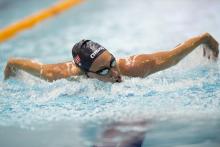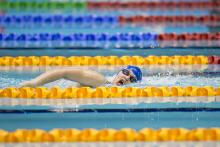Sport week: Introduction to swimming
The basics of one of the most popular sports on the Paralympic programme. 18 Apr 2016Editor’s note: Each sport on the Rio 2016 Paralympic programme will have a dedicated week of featured content published on paralympic.org. Every week a new sport will be featured and the series will run until September’s Games, helping the public understand more about the 22 sports being contested in Rio.
As one of the original Paralympic sports, swimming has grown into one of the most challenging, exciting and popular sports on the Paralympic programme.
It provides competition for athletes with physical, visual and intellectual impairments in 152 medal events.
Athletes compete for medals in freestyle, breaststroke, medley, backstroke and butterfly in distances ranging from the 50m sprint to the endurance test of the 400m.
Men’s and women’s team relays are also contested in 4x100m freestyle and medley, as well as the mixed 4x50m freestyle.
Is Paralympic swimming the same as Olympic competition?
Paralympic swimming uses the rules of the International Swimming Federation (FINA) with a few modifications.
The competition pool is always 50m in length and at Paralympic Games, the same pool is used as the Olympic Games.
Events are conducted as heats for eight competitors per class, with the fastest eight swimmers per class competing in the finals.
Athletes can start the race in a variety of positions;: in the water, a dive start sitting on the starting platform or the typical standing start.
No prosthesis or assistive devices are allowed in the competition pool and athletes are not allowed to use anything that may aid their speed, endurance or buoyancy. Goggles and swimming caps are permitted.
Visually impaired athletes can employ the use of a ‘tapper.’. A tapper is a long stick with a tennis ball or similar on the end, which is used by a coach or team official to touch the athlete when they are approaching the wall. Spectators will notice that different swimmers are ‘tapped’ in different places – some on the back and some on the head, for example.
This helps the swimmer to judge when to turn or execute their finish.
Visually impaired athletes in classes S/SB11 must use a tapper and must compete with blackened goggles. Those in S/SB12 and S/SB13 can choose if they use a tapper.
Uniquely, athletes in classes S4 and S3 compete in the 150m individual medley, which omits the butterfly stroke.
Viewers will also notice that athletes without arms touch the wall with their head to finish a race, or start by holding onto a towel with their teeth attached to the starting platform.
What about the relays?
There are five relay events on the Paralympic programme –: the men’s and women’s 4x100m freestyle 34 points and 4x100m medley relay 34 points, and the mixed 4x50m freestyle 20 points.
The points element is based on the make-up of each team and allows a combination of different impairment groups in each team. The sport class of an individual swimmer is worth the actual number value. For example sport class S6 is worth six points, sport class SB12 is worth 12 points, etc.
Each team’s points total must not exceed the limit for the event, and the teams can choose which athletes swim each leg.
Classification
The sport class names in swimming consist of a prefix “S” or “SB” and a number. The prefixes stand for the strokes and the number indicates the sport classes. The prefixes stand for:
•S: freestyle, butterfly and backstroke events
•SB: breaststroke
•SM: individual medley. The prefix “SM” is given to athletes competing in individual medley events. It is not a sports class, but an entry index that is calculated from the combination between the S and SB sport classes.
There are 10 different sport classes for athletes with physical impairment, numbered 1-10. A lower number indicates a more severe activity limitation than a higher number.
Due to the different demands of S and SB events, swimmers with physical impairments are often allocated different S and SB sport classes.
Visually impaired athletes compete in classes 11-13 and intellectually impaired swimmers in class 14.
Intellectually impaired athletes may have difficulties with regards to pattern recognition, sequencing, and memory, or having a slower reaction time, which impact on sport performance in general. Moreover, S14 swimmers show a higher number of strokes relative to their speed than high performance able-bodied swimmers.
Dedicated information on classification will be published later on the IPC website in this Sport Week feature series.
Helpful links
Guide to classification in summer Paralympic sports.
___
Sport fans from around the world can now buy their Paralympic tickets for Rio 2016 from authorised ticket resellers (ATRs).
The IPC’s Global ATR is Jet Set Sports, and Rio 2016 tickets and packages can be purchased on the CoSport website.
Residents of Brazil can buy 2016 Paralympics tickets directly from the Rio 2016 website.

 Facebook
Facebook
 Instagram
Instagram
 Twitter
Twitter
 Youtube
Youtube
 Tiktok
Tiktok











